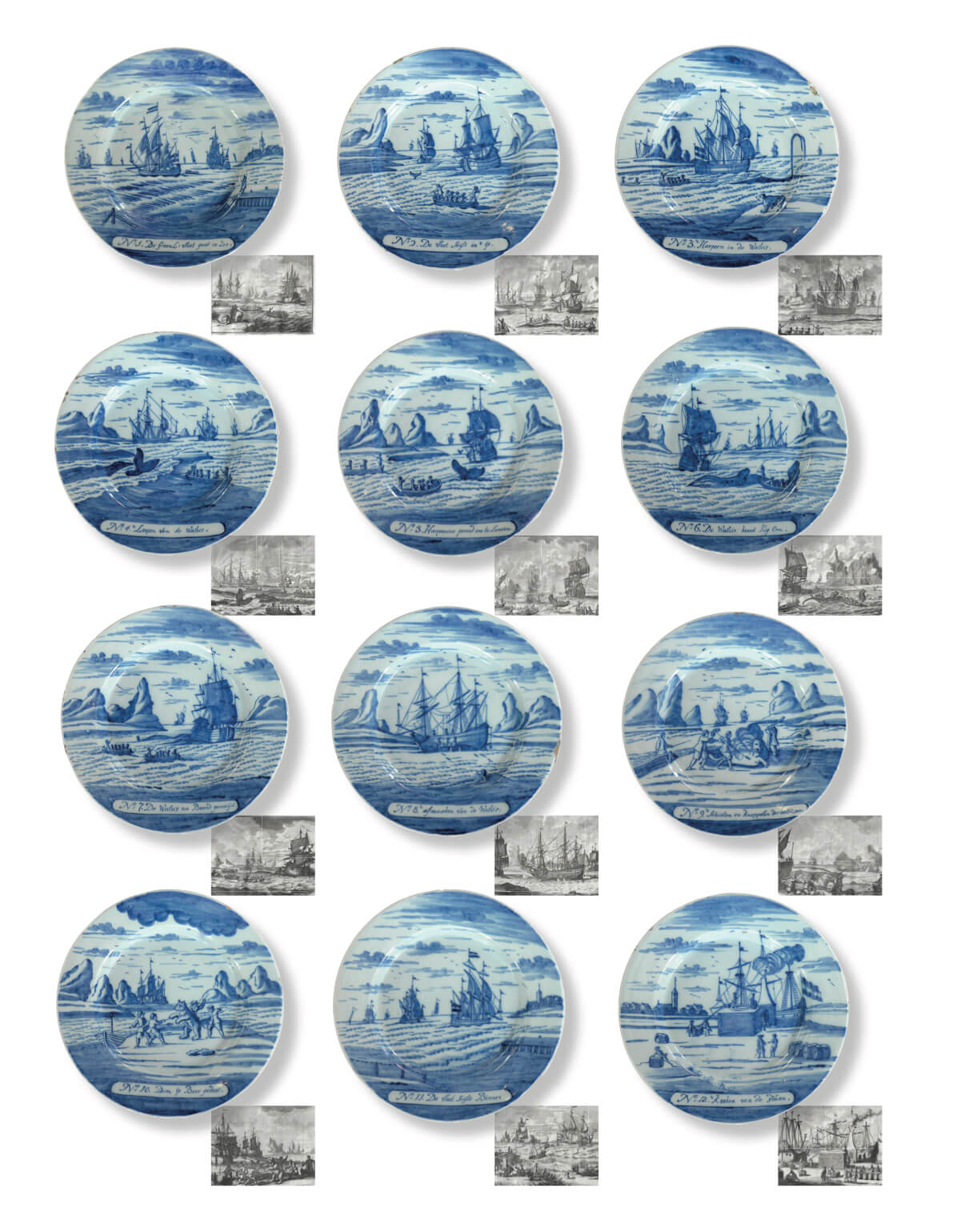
[popup_trigger id=”13756″ tag=”span”]![]() [/popup_trigger]
[/popup_trigger]
Images on this website are licensed under a
Creative Commons Attribution-NoDerivs 3.0 Unported License.
OBJECT
•D1974. Set of Twelve Blue and White Whaling Plates
Delft, circa 1775
Marked with an axe in blue for De Porceleyne Byl (The Porcelain Axe) factory
Each painted with a different scene of the whaling trade above a numbered label inscribed with the activity depicted:
No 1. De GroenL:Vloot gaat in Zee. (The Greenland fleet goes to sea.)
No 2. De Vloot Seijlt in ‘t ijs. (The fleet sails into the ice.)
No 3. ‘t Harpoen in de Walvis. (The harpoon in the whale.)
No 4. ‘t Loopen van de Walvis. (Tiring the whale.)
No 5. Harponiers gereed om te Lenssen. The harpooners ready to spear.)
No 6. De Walvis keerd Zig Om.(The whale turns over.)
No 7. De Walvis na Boord geroeijd. (The whale hauled to the side of the ship.)
No 8. ‘t afmaaken van de Walvis. (The slaughtering of the whale.)
No 9. ‘t Schieten en Kneppelen der walrùssen. (The shooting and beating of the walruses.)
No 10. Den ijs Beer gedoot. (The polar bear killed.)
No 11. De Vloot Seijlt Binnen. (The fleet sails in.)
No 12. ‘t Kooken van de Traan. (The boiling of the whale oil.)
Dimensions
Diameters: 25 cm. (9.8 in.)
Provenance
Aronson Antiquairs, Amsterdam, 2005; Dutch Private Collection
Note
The series of twelve ‘Whale Fishery’ plates has a counterpart series of twelve ‘Herring Fishery’ plates. Both series are decorated after the print series of the “Groote Visserij” (“Great Fishery”) engraved by Adolf van der Laan (circa 1690-1742) from drawings by Sieuwert van der Meulen (before 1683-1730), and published by Petrus Schenk in Amsterdam around 1720. Whereas the two Delft series are limited to twelve plates each, both print series contain sixteen prints: the herring series numbered 2-17, with the title page as no. 1, and the whaling prints numbered 1-16. Whale “fishing” took place from April to August in the Greenland seas, and from about 1720 also in the Davis Strait west of Greenland. During the seventeenth century, whaling progressed from bay and coastal waters to the open sea, and finally to the arctic waters, as illustrated on these Delft plates, where the whales would swim along the ice floes in search of plankton.
The Greenland ice fishery required better protected, stronger-hulled ships, the so-called ‘Groendlandvaarders,’ whereas in the Davis Strait lighter ships could hunt. But all of the whaling ships were characterized by a large horizontal beam across the width of the stern from which the harpoon boats were lowered for the harpooners, largely hired from the Basque region of Spain, to hunt and kill the whale. While the catch from coastal or bay whaling could be processed promptly in cookeries on land, for whaling on the open seas, time, geography and distances were such that the whales had to be slaughtered alongside the ship. The meat and blubber were barreled aboard the ships, and after the return of the fleet to the Dutch harbor, they were reduced to oil.
Similar examples
A complete set of twelve whaling plates marked for ’t Fortuyn (The Fortune) factory is depicted in Aronson 2010, p. 150-151, no. 90. Plates from the whaling series, all from De Porceleyne Byl (The Porcelain Axe) factory are illustrated by Charleston and Lunsingh Scheurleer 1979, monochrome pl. 90 (plate No. 6); Boyazoglu and de Neuville 1980, p. 124-125, pls. 135-138 (plates Nos. 6, 3, 5 and 12) and p. 145, pl. 153 (plate No. 10); Fourest 1980, p. 126, pl. 121 (plates Nos. 6, 4, 2, 11 and 3); Helbig, Vol. I, p. 210, fig. 155 (plate No. 7); Lunsingh Scheurleer 1984, p. 282, pl. 265 (plate No. 4); Morley-Fletcher and McIlroy 1984, p. 220, no. 12 (plate No. 4).








